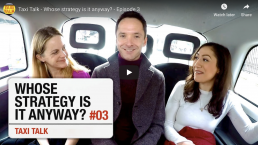Believe
We at Salt have been chatting a lot recently about the fact that we’ve not written a blog since last year. It’s sad how these are the things that are first to go when there is a lot of work on, and given our last post was about the joys of cashflow it was pointed out to us recently (thanks Stuart!) that we may have left the wrong impression. Thank you for the nudge, we are back writing again, talking about what we believe in, ensuring we don’t forget the details or what’s important to us as our business grows.
Something that has been niggling in my mind for some time is around continuity of thought. We are living in exciting times, communication wise that is, before anyone points out the political and humanitarian climate that sometimes quite frankly beggars belief. As an industry, we’re investing more and more time into really understanding business challenges, ensuring we get to the crux of the issue, and our audiences, to find out what makes them tick, what type of behaviour they exhibit and how can we connect emotionally with them in order to ultimately change behaviour. Essentially, how can we make it less ‘us and them’ and more ‘we’.
Coupled with outward exploration we are also spending more time with brands and their teams, to understand them, in better ways than ever before. It’s incredibly powerful to look not only at our customers but also at ourselves, to decide who we are and how we want to be seen. Ensuring the team is aligned on the approach so we are united and empowered to do the best we can, together, and creating positive change as a result.
Unfortunately, these valuable preparations all too often fall at the final hurdle when we look to deliver on them. Without implementing this with the conviction and belief needed, or without using all these learnings along the way, we will end up just talking the talk rather than walking the walk with our heads held high. The people we’re looking to influence aren’t stupid and will be able to see this a mile off, or completely miss the original intention of what we are trying to say. They need to be able to join all the dots and do so very quickly to feel a connection and relate to what we’re communicating.
Now I know we don’t live in a utopian world where everyone runs through fields of corn without a care in the world, but even if we are working with budget restrictions, historic campaign equity, and multiple stakeholder views we still need to ensure we stay on course and true to the core insights uncovered at the beginning of the project.
We need to keep the momentum going. Continue to challenge the status quo, stay true to the decisions made with the same passion we had to begin with, and don’t compromise on the core brand as this is who we are. Invest carefully in execution, the craft and detail all matter, and ensure it is based on all this wonderful and valuable research and nothing else.There are so many points along the journey when you can take the easy path, and it takes a lot more time, effort and commitment to stick with your beliefs when timelines and budgets may tempt you away. But if you do, what you produce and the impact it has will be so much richer and more rewarding in return. So let’s keep doing it.
How can this be okay?
Salt is now in its second year, and things are going well. We’re getting busier by the day, with lots of new clients coming on board and existing work expanding into new areas. So how come our cash surplus is disappearing before our eyes, and our bank balance is fast approaching zero?
It’s no surprise that cashflow is one of the biggest challenges for any business, especially a start-up. We started our business with nothing – no clients, no funding, no loans and no overdrafts – so we knew it would take a while to get things going. Once that started happening, thankfully only a few months in, we were able to play catch up and keep ourselves afloat. Small and midsized companies generally seem to understand and appreciate this situation, and manage their finances accordingly to honour their payment commitments to the letter. Unfortunately, we are seeing more and more cases where the larger, global organisations do not.
Large corporations, with annual revenues over $30bn, appear to have a systematic culture of late payment, and I am yet to work out why. Is it because those extra weeks keeping hold of your budget gives them an advantage? Is it just laziness or inefficiency? Is it that they simply don’t appreciate that withholding funds can put small businesses at risk? Or is it a power trip – they know they can get away with it? Who knows. An awful lot of time and energy is put into negotiating a contract, yet it seems to mean very little when one side can break it at will. Somehow dealings between two businesses don’t need to conform to the same principles we might put on a person-to-person interaction, and it makes it okay to break the rules without explanation, apology, accountability or consequences.
Being business to business can make the conversation, decisions, actions and principles less human, so it suddenly becomes okay not to pay people what you owe, blaming the system and the rules rather than seeing that it is clearly unfair and taking responsibility. I see no reason why commitments should be any less important in the commercial world than they are in the personal world, particularly if the relationship is valued. And that’s always a sticking point – the clients we work directly with do value the relationship, as do we, so inevitably it is the small businesses that have to compromise in order to maintain it. It is the small business that is asked to start work without a PO, deliver work with no idea of when they might be paid, and take on all the financial risk and burden associated with doing a good piece of work in the spirit of ‘partnership’. It’s totally out of balance, and plays on people’s good nature, willingness to do good work and not wanting to be the one who prevents something from happening. And clearly, a small business is never going to sue a global corporate entity for not fulfilling their contractual obligation to pay on time, so all is well.
Or is it? Is it okay for small business to bankroll gigantic corporate entities? Should we be taking all the risk, uncertainty and cost of bridging the gap? Should we accept that so many good small businesses go under because of these sorts of practices?
We operate our business fairly. That means we pay our associates and partners on time, and we respect their need to run a business as much as we do our own. Because for us, money committed is just that – a commitment, a promise, and fair remuneration for good work. Working this way leaves us exposed in the middle – honouring our payment commitments without being able to rely on the same for our income. Some people may say it’s naïve, but we feel good business is all about being true to your principles. Agencies don’t want to be in a relationship where all the power sits on one side. We choose to work with people who respect us for what we do, are excited to be a part of our journey, and are willing to push on our behalf. And there are plenty of those around.
Right, now I’m off to press refresh on our online banking…
I love it, but can you make it blue?
Where do ideas come from? Truly come from? The great ones, and even more so, the exceptional ones, are brought about through a need. A need to fill a gap, a frustration of something not working properly and wanting to make it better, to express something in a new and interesting way, or to overcome a problem that hasn’t been solved.
The journey to forming ideas can take you to some really exciting places that you never would have imagined from the outset. Whether I like blue or not, relate R&B to a form of sadistic torture or spend a large proportion of my time thinking about food is largely irrelevant in most cases. What matters are the thoughts, behaviours, and lives of the people your ideas need to make a difference to.
Ideas need to be brought to life and made great through interrogating the need. Understanding the root of the problem, the target audience and constraints, looking at it from every angle to ensure that whatever the solution, it is as robust, distilled and impactful as possible. This means, especially in the area of health, that it needs to be evidence based. Rooted in an understanding that makes the answer undeniably right and strong.
We recently developed some ideas for an engagement programme to empower a traditionally hard to reach community to take control of their health. One of the core initiatives we proposed was, on the surface and out of context, really random. I’ll admit it was an idea out of my comfort zone and something that wouldn’t interest me in the slightest. In fact, it’s the kind of thing that would make me feel uncomfortable and self-conscious. But then it wasn’t aimed at me. All of the research we conducted and insight we gathered suggested that this was a great way to reach this particular community and motivate them to act.
Being able to separate yourself from your predilections, to open and allow your mind to explore new ideas and ways of thinking based on strong and relevant insights, can really create incredibly powerful results.
If an idea is rooted in good insight, then it is hard to refute. If it truly solves the problem or need set out in the first place then personal tastes, feelings or opinions shouldn’t hold any weight. Subjectivity has no place here.
Bad behaviour
Behaviour, ‘The way in which one acts or conducts oneself, especially towards others’
In other words, everything we do. The decisions we make, the way we act, the things that show people who we are.
There is so much talk about behaviour change, it’s become a buzz word. But how often do we really aim to understand behaviour, or are we really just tying to manipulate, influence and persuade someone to do something differently? Isn’t that what marketing and advertising are all about? Actually, I don’t think so.
Understanding someone’s behaviour isn’t about using it against them to hoodwink them into doing what we want them to do. It’s not about covert, subconscious ways of brainwashing people into buying what we have to sell, nor is about selling to people without them realising they are being sold to. It’s about understanding who people are and what makes them tick, so we know who we can be most relevant and meaningful for. Genuinely.
People aren’t defined by a set of demographics – I am not a a clone of every other woman in her 40s living in the London commuter belt. It is my behaviour that defines me as being me, not the facts and data about my age, where I live or what I had for dinner last night. That is equally true for an oncologist looking after people with cancer, an NHS commissioner trying to make the most out of limited resources, or a person coming to terms with a Type 2 diabetes diagnosis.
There are so many cases of behaviour impacting real-life situations in health. GPs are more likely to prescribe antibiotics just before lunch and at the end of the day, when they are weary from patients persistently demanding them. A break over lunch and they re-set their energy and resilience. People with asthma might take their inhaler diligently to start with, but gradually get complacent and feel they no longer need it, until the day they wake up finding they are struggling to breathe. I know, I am one of them, and I have given myself a stern talking to (as has the asthma nurse, who remained patient and supportive despite seeing people harming themselves like this through non-compliance every single day).
We are all people, and labels like ‘HCP’, ‘payer’ or ‘patient’ don’t help to give any understanding of who we really are. So we shouldn’t feel the need to label people like this, instead we should get to know people. Talk to them, understand what drives them, what scares them, why they do what they do. Treat them like human beings, not boxes in a survey. Then we can understand what makes them tick, what they are looking for and how we can help them with whatever it is they are looking to achieve.
Understanding people makes so much more sense than bucketing people. It’s better for them, and it’s better for us as we’re more likely to be heard. Understand people and we can talk to them in a way that suits what they need.
Behavioural insights are still largely considered to be unnecessary – not a core part of what we need to do. Why on earth not? The upfront investment can reap rewards and make everything else more efficient and effective, with proven ROI. Maybe people prefer to keep doing things the same old way, crossing their fingers that they’ll get something different and more effective out of the other end.
If we want communications to be more effective, and genuinely make a difference, we should stop thinking about how to convince and persuade, and instead start thinking about how we can listen and understand. It’s a win-win.
The illusion of balance
I doubt that anyone would disagree that a good work/life balance is a good thing, but seemingly this, for many, is only a theoretical aspiration. Why does this possibility go out the window when it comes to practice?
Why do so many people find themselves working crazy hours week in, week out, with no light at the end of the tunnel? And at what cost does this all-consuming element have on the rest of workers’ lives?
Seemingly gone are the days of a Monday to Friday 9-5 job. What is put down as core contracted hours are rarely achievable as companies expect more and more commitment from their staff, measured by time in the office. Even to the point where colleagues who leave on time are being marked down for doing so. Or asked if they are ‘doing a half day’. Instead of being congratulated for managing their time so effectively that they are able to do so. In many companies it is seen as the only way to move up the corporate ladder. Waiting until the boss has put their coat on and has one foot out the office door before feeling able to shut down and finally leave, whether they’ve had work to do or not. According to the TUC, workers in Briton in 2016 put in 2.1bn unpaid hours.
What kind of culture are we setting in the workplace when this is deemed the norm, or an expected way of working, and what kind of message does that give to our clients?
This is not helped by the continued cuts to employees, increasing the workload for the remaining few. Not only does this add exponential pressure, but increases the chance of people working in silos, unable to afford time to work collaboratively or support one another.
Given that companies still constantly talk about their staff being their most important asset, none of these actions indicates this to be true. There must be a better way. If work becomes a chore, and too pressured then people will start to resent it. Certainly within my own section of the industry, creativity is not something you can overly pressurise without expecting something to be compromised. The answers are not a one size fits all that can be turned on and off at will. People can’t function creatively 120% all the time. Something is going to give, either the quality of work, their passion and drive in the project or their health, both mentally and physically.
Anxiety, stress, depression or burn out are the only winners in these scenarios. People look after themselves less well through lack of sleep and because they are time poor, eating crap because their body needs quick fixes. Then they reward themselves at the end of the day with alcohol in order unwind and help them get to sleep, which will undoubtedly be poor sleep and so the cycle continues. Coupled with the fact that they have no work/life balance so cracks will start to show in relationships with partners, friends, and families who have been de-prioritised.
I realise that I am in danger of going off into a rant, if I’ve not done so already, but hopefully you’ll agree this is not wholly unfamiliar.
Now I’m not suggesting that we should do a complete 180 and everyone should be slacking off. Far from it, people can work incredibly hard in a concentrated amount of time, and from places other than the office. The time spent on something isn’t the same for the quality produced. The age-old quality, not quantity saying works to great effect here. Evidence suggests that productivity actually increases hour for hour if you work fewer hours overall. And if people are less stressed they are less likely to be off work.
Trust people more, give them more responsibility and ownership of the work they have been tasked with. They know the deadlines and when work needs to be reviewed and delivered. If we can’t even do that, why did we employ them in the first place? And if they don’t deliver, they are also clever enough to understand the consequences.
With the advancements of technology, the world is becoming much smaller with many more ways to connect to people. This enables us to work more remotely, on the move, more flexibly to enable juggling work and life to better effect, suited to the needs of the individual.
We need to embrace change and the possibilities now available to us, and use them to our advantage. By thinking of ways to do more with less, and without that meaning piling more pressure on already overworked staff, we can ensure that our most important assets are respected and treated fairly, and that the work produced will be the best it can be.
Why is pharma so antisocial?
My GP has a mug on his desk that says ‘please don’t confuse your Google search with my medical degree’. People are more information hungry than ever, and when faced with a health problem the first instinct is to google it, just like everything else. We are used to finding everything at our fingertips, and being able to converse on any topic at any time.
So there’s a huge health conversation online, but the pharma industry is still largely absent from it, with only a few cases of pharma companies using social channels well. Why? Primarily a lack of confidence in how to manage social media without getting into trouble. But social media isn’t about selling drugs, it’s about having conversations. So surely we can get over this by now?
In the time pharma has been twiddling its thumbs, the social media universe has become much more sophisticated. The longer they’ve been absent, the harder it is has become to jump on board. It’s not about throwing out the odd tweet here and there, a social presence needs to be well considered, and the goals and objectives need to be realistic and defined.
In the end, it’s about being human. Approachable and interested rather than aloof and unreachable. It’s about having a conversation and allowing people to get to know you, engage with you, and to engage with them in return. It means you need to understand who you are talking to, and what they want or need to hear. It definitely takes commitment – if you’re going to do it you need to be confident you’re going to do it properly – which, I suspect, is why so many still haven’t taken the plunge.
Creating a connection with people you’ve never met is normal now, and it’s easy to assume that anyone who isn’t ‘out there’ simply doesn’t care enough to bother. They’re antisocial. The pharma industry has played a significant but silent role in people’s lives for a very long time, and now we have the chance to strike up a conversation. Let’s take it.
Being social
Being social used to mean being just that. Now it means almost the opposite – being glued to a device and barely making meaningful contact with other human beings in the real world.
Now, I’m not in any way against social media (that would be ironic for a post shared through social channels), but has our obsession been at the expense of real-life interaction, instead of in addition to it? Research has shown that virtual interactions don’t produce the same responses in the brain as interactions face-to-face. Even simple things like making eye contact with someone can increase dopamine and oxytocin, and decrease cortisol, reducing stress, increasing trust and improving mood.
And it’s much more powerful than that – Professor Julianne Holt-Lunstad studied the impact of different lifestyle factors on how long we will live. She discovered that some of the physical factors we focus so much on, like being overweight or exercising regularly, only had a moderate impact on life expectancy, and the biggest predictors by far were whether or not people have close relationships and regular social interaction. Research by Prof Clive Ballard also showed that dementia patients spending just 10 minutes a day having a one-on-one social interaction can improve their quality of life, agitation levels and neuropsychiatric complications. That’s the kind of response we might only expect to achieve with hard drugs, not a simple chat.
Physical factors are obviously important, but the focus on physical vs psychological factors is clearly out of kilter. We could all improve our health and wellbeing, and expect to live longer as a result, if we preserve time in our busy lives for talking to people. For most of us that’s pretty easy, but not for everyone. In her recent TED talk, psychologist Susan Pinker stated that “social isolation is the public health risk of our time”.
Channel 4’s Old People’s Home for 4 Year Oldsrecently highlighted a beautiful example of how human interaction can improve our wellbeing. A group of 4-year-olds spent six weeks at an old people’s home, and in that time the senior volunteers showed dramatic improvements in their mental and physical health scores. People who felt they could only walk with a zimmer frame were seen chasing the little nippers around playfully, totally forgetting their physical inabilities. More anecdotally, the older participants said they felt more alive and that being with the children had been like having a shot of adrenalin. There it is again – human interaction having the impact we might only expect from a drug.
So, shouldn’t we be doing much more to recognise the power of human interaction in improving our mental and physical health? In the communications industry, everything we do is about having conversations with people, but it feels like we’re often so focused on how to talk to people, that we forget the importance of actually talking to people.
We need to make it happen. So go and find someone to have a chat with, and maybe you’ll both feel better for it.
Creativity shouldn’t be an afterthought
I had a really interesting conversation last week where I was pretty much told that what I am passionate about and do for a living is meaningless and doesn’t make a difference. On the surface I was, I’ll admit, rather taken aback. I needed to take a few moments to compose myself and construct a rational response to disprove this theory. What we did agree on is that if a creative solution isn’t grounded in solid insight and behavioural understanding to ensure its relevance, validity, and resonance, then it is unlikely to stand a chance of affecting maximum positive change. Also that this creative solution shouldn’t be limited to a list of old favourites; a video, logo, PPT, or A5 leave piece, but could be anything that best creatively solves the problem.
There is definitely room to pause here for a second to define what I mean when I talk about being creative. It is not the design or the copy alone, it is how everything that sits behind this is built to inform it, and link to how it is designed and written. To give a brand or product meaning requires an understanding much deeper, coupled with a universal belief and agreement by all parties involved to move in the same direction and act accordingly. I remember one of the hardest projects I ever had to do was when someone asked me to design a promotional leaflet, asking me to ‘make it look pretty’! I didn’t know where to start; who is the audience?, what is the key message?, what do we want them to do?, where are these leaflets going to be handed out or placed?
In order to achieve as much impact as possible, creativity needs to be considered much, much sooner than it usually. It should be integrated from the start to ensure everyone and everything is aligned and so that the ideas that are built off the back of the strategic approach are not rushed, are thought through and are robust enough to do all the initial hard work justice. It seems crazy that all of the upfront thinking is given weeks to build and develop, done in isolation away from the full team, and then when all of this great thinking needs to be developed into an idea and brought to life, the people tasked with doing so are hitting it cold. And they’re often hounded and rushed to execute it.
Creativity doesn’t start with copy and design, it starts with thinking differently, right from the start, about strategic and creative approaches to problems. Changing the antiquated habit of treating creativity as an end product will ensure that the results are more aligned, impactful and will make the differences that was hoped for at the beginning of the project.
Whose strategy is it anyway?
provider: youtube
url: https://www.youtube.com/watch?v=ItrAevb-zU4&feature=youtu.be
src in org: https://www.youtube.com/embed/ItrAevb-zU4?feature=oembed&width=840&height=1000&discover=1
src in mod: https://www.youtube.com/embed/ItrAevb-zU4?width=840&height=1000&discover=1
src gen org: https://www.youtube.com/embed/ItrAevb-zU4
In this third episode our three contributors Kath, Richard and Haifa grapple with a question that repeats more frequently than a garlic vol-au-vent: Whose strategy is it? (strategy that is)
Let’s build a strategy!
All too often it feels like the strategy for any brand is recreated a million times over, because everyone who comes into contact with it wants to add their two pence, and show they understand the problem better than everyone else. This means the strategy ends up being a jumble of disconnected thoughts – a noisy mess that achieves little more than to bombard the target audience with meaningless stuff. Instead, the strategy should be something to build and grow, not to periodically scrap and start again. That means it’s hard work – it needs to be more considered from the outset, and more applicable to the endpoint.
Strategy doesn’t stop once the direction is set, we still need to get there. The commonly held belief that delivering against a strategy is somehow the poor cousin of developing one is frustratingly out-dated. What use is a strategy if it isn’t delivered? Delivering against a strategy is often harder than developing one, but so many people are so quick to say ‘that’s not my job’? It’s not about where one job stops and another job starts, it’s about creating seamless understanding and ownership.
For this reason, and because it makes damn good sense, developing the strategy should be much more inclusive, not left to the select few who have permission to be smart. No one has all the answers, but a lot of people have some of them. Then it needs to be focused down, and we need to be strict with it. Once it’s done, everyone needs to believe in it and make it happen. It’s a collaborative process, not a competition.
Of course, it needs to be clever in thought, genuinely well informed with insight, and big enough to cover the whole marketing mix. But it also needs to be meaningful, bringing with it a promise to change things rather than just communicate things. That way the strategy won’t be a piece of academic theory that never sees the light of day, it will readily translate into practice.
In the end, this allows the strategy to achieve what it set out to do in the first place – have a positive impact in the real world. Isn’t that what we’re doing this for?









